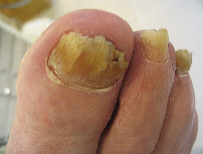 A fungal nail infection can look unsightly but it is not serious and is rarely painful. The nail often becomes thickened and can turn white, black, yellow or green. The nail can sometimes become brittle, with pieces of nail breaking off or even coming away from the toe completely. The skin can sometimes become inflamed and painful underneath and around the nail, but this tends to suggest a yeast infection. A fungal nail infection is not serious, but it will not clear up on its own and requires treatment with antifungal medicine. The medical name for a fungal nail infection is onychomycosis.
A fungal nail infection can look unsightly but it is not serious and is rarely painful. The nail often becomes thickened and can turn white, black, yellow or green. The nail can sometimes become brittle, with pieces of nail breaking off or even coming away from the toe completely. The skin can sometimes become inflamed and painful underneath and around the nail, but this tends to suggest a yeast infection. A fungal nail infection is not serious, but it will not clear up on its own and requires treatment with antifungal medicine. The medical name for a fungal nail infection is onychomycosis.
You are most likely to get a fungal infection if:
- You walk around barefoot in places where fungal infections can spread easily, such as communal showers, locker rooms and gyms.
- You don’t keep your feet clean and dry.
- Wear shoes that cause your feet to get hot and sweaty.
- Have a weakened immune system or
- Have certain other health conditions, such as diabetes, psoriasis or peripheral arterial disease.
Treatment for Fungal Nails
Always practise good foot hygiene to stop the infection getting worse or spreading to others.
Speak to your GP, pharmacist or Foot Professional if you’re bothered by the appearance of the affected nail, or it’s causing problems such as pain and discomfort.
Different antifungal nail paints can be used.
Testing the fungus by taking clippings and sending off to the lab may be necessary in some cases.
Treating some cases with a method done by “fenestration” of the nail. The act of drilling small holes in a nail. These holes then act as a passage for topical anti-fungals, which treat the active tinea.
